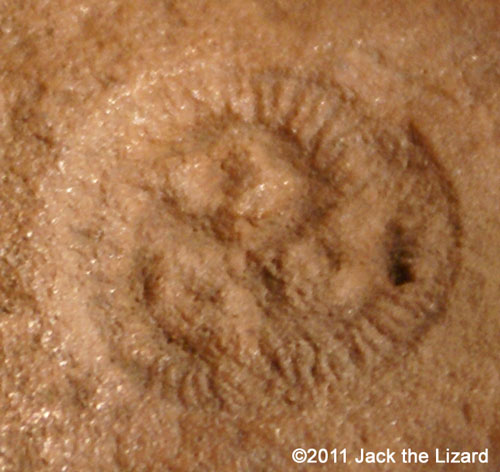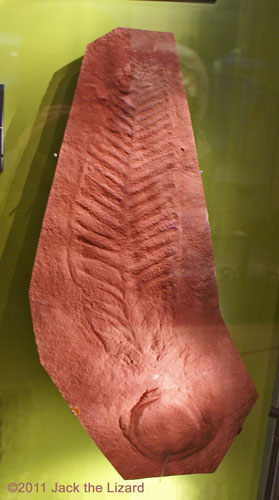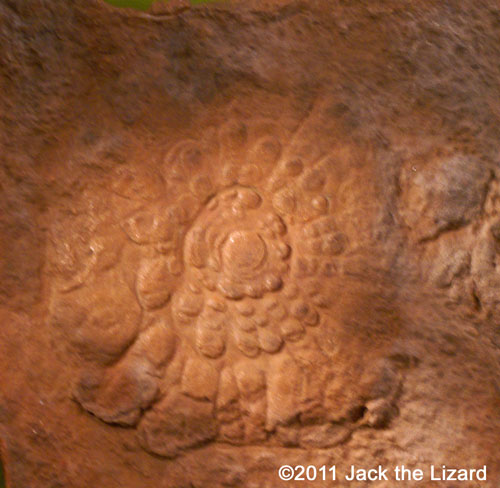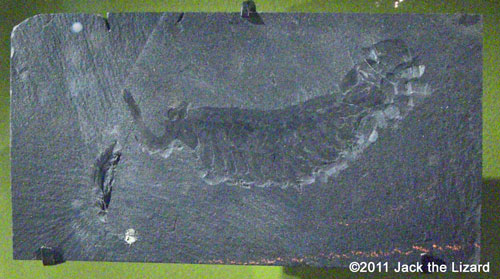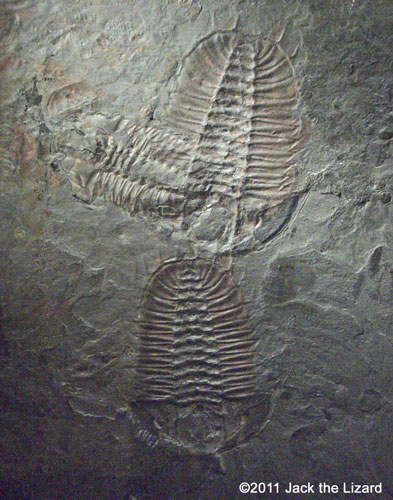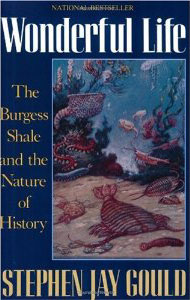
|
LONG BEFORE DINOSAURUS |
|
|
|
Jack the Lizard is on YouTube |
From Precambrian to Permian |
 Jack the Lizard
Jack the Lizard
|
First Life Appeared on the Earth
When did the first life appear on the Earth? Some think life existed when the ocean appeared on the Earth 4 billion years ago. General understanding was that life began at least 3.5 billion years ago according to the fossil record. The well known proof is the stones from Pilbara, North West Australia. Small lives found on those stones were microbes in the ocean. Besides, there were older rocks found from Akilia Island off the coast of Greenland. The scientists and paleontologists noticed some signs of life in those rocks which were 3.8 billion years old. Then the most influential life in the atmosphere was found on the 2.7 billion year old rocks from the Fortescue Series in West Australia. This first photosynthetic life was blue-green algae, called “Cynanobacteria”.
Photosynthesis generated oxygen on large scale and it was accumulated slowly from around 2.5 billion years ago. This phenomenon is called Great Oxidation Event. Through this event photosynthesizing bacteria and plants evolved for several billion years and gradually they diversified in the ocean and eventually on the land. As oxygen levels increased, carbon dioxide levels dropped. The first multi-celled organism was evolved 1.2 billion years ago. That is red alga, Bongiomorpha pubescens. One of the specimens was found in the rocks from the arctic of Canada. Numerous fossils suddenly appeared in the rocks which are 600 million years old and younger. Many of them have shells or hard skeletons, and some look like animals from the modern world. Those mark the opening of Cambrian Period, the beginning of Paleozoic Era. |
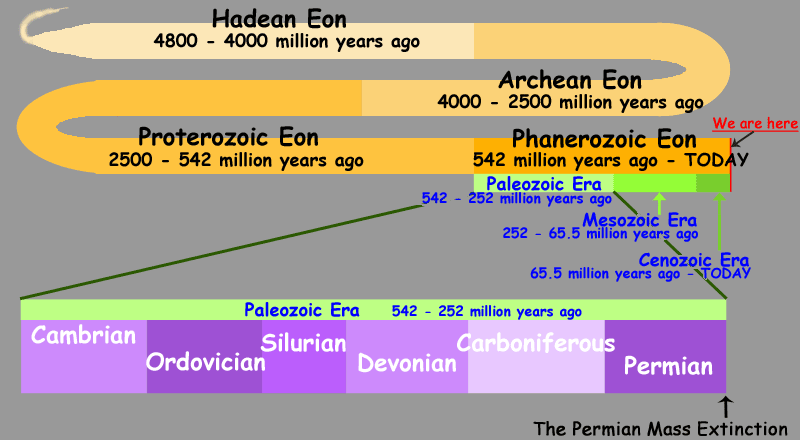 Cambrian Period (542 – 488 million years ago) Ordovician Period (488 – 444 million years ago) Silurian Period (444 – 416 million years ago) Devonian Period (416 – 359 million years ago) Carboniferous Period (359 – 299 million years ago) Permian Period (299 – 251 million years ago) (The geologic time scale is referred to National Museum of Natural History, Washington, D.C., USA) |
So Many Wonders were Preserved
Cambrian Period (542 – 488 million years ago)
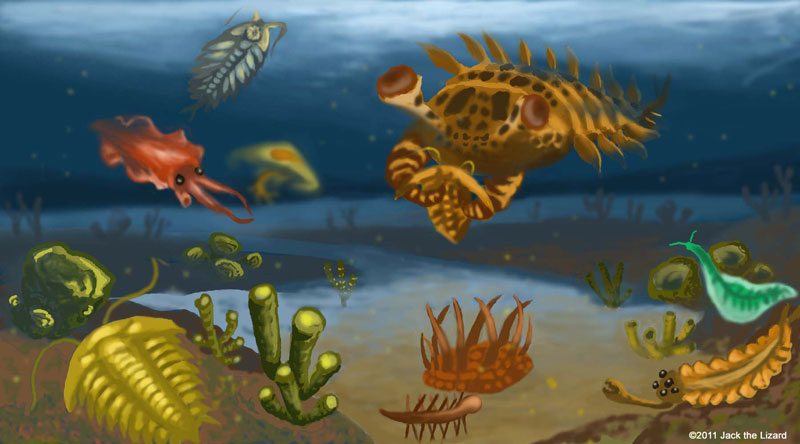
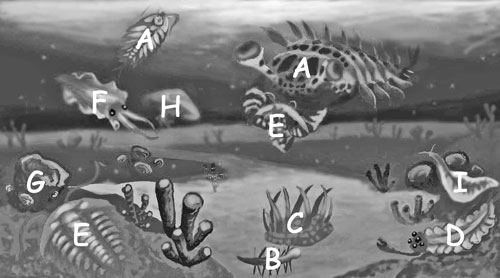
|
|
|
The number of animals increased in the ocean, and we can see those because many of them were fossilized. That is called Cambrian explosion or Cambrian radiation. So many Variety of different body plans were developed so quickly at this time. The animals evolved forming hard parts such as shells or bones. Those structures offered the animals stronger protection, greater body size, variety of body shape, new ways to move and so on. One of the biggest animals of the Cambrian Period is Anomolocaridids. Anomolocaridids had streamlined bodies that allow them to move speedily through water. Their jagged teeth were able to crush trilobites and other arthropods. | |
 Helicoplacus sp., Echinoderm Early Cambrian, Uncertain Location |
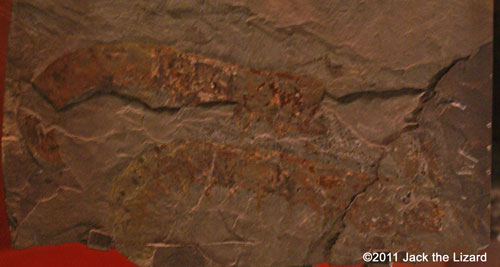 Anomalocaris canadensis Uncertain Relationship Middle Cambrian, British Columbia |
Burgess Shale - Amazing Forms of Diversified Lives
Charles D. Walcott discovered the Burgess Shale Formation in the Canadian Rockies in 1909. The Burges Shale preserved the fauna of the middle Cambrian sediment. More than 65,000 specimens, fossils of soft and hard bodies were collected from this stratum.
 Jack the Lizard
|
Ordovician Period (488 – 444 million years ago)
 Urasterelia grandls, Sea Star Ordovician, Waynesville, Ohio |
Echinoderms had evolved tremendously in a variety of forms during the period. The most abundant and varied were the crinoids. 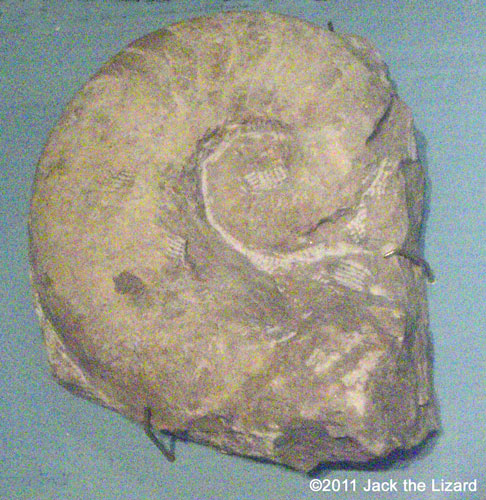 Cumingsoceras elrodi, Cephalopod Indiana |
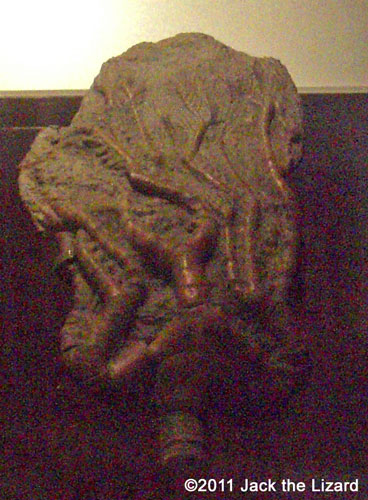 Anomalocrinus dumalis, Crinoid Ordovician, Marrow, Ohio |
Silurian Period (444 – 416 million years ago)
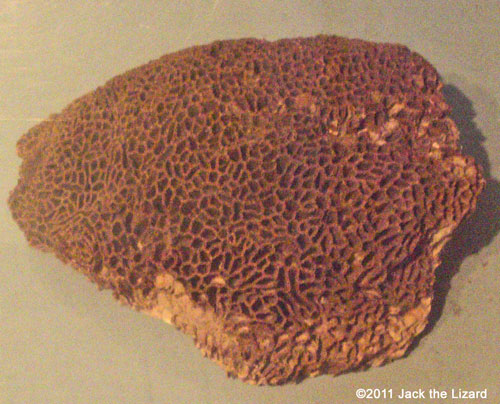 Halysiters catenularia, Coral Iowa |
There were large sea scorpions called “Eurypterids“ in the ocean. Many of Eurypterids fossils have been excavated. The biggest one is 2.5 meters long. While the preys such as jawless fish or arthropods, developed hard parts like shells to protect themselves, Eurypterids had pincers and spikes to grasp preys and stab them to eat. 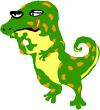 Jack the Lizard |
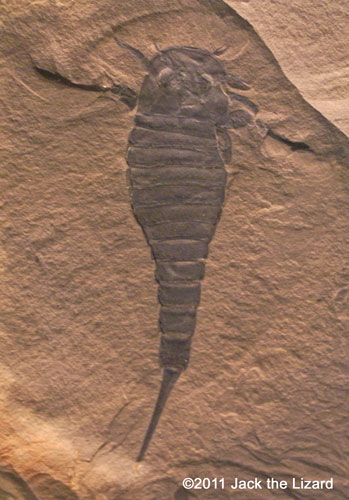 Eurypterus remipes Middle Silurian, New York |
Devonian Period (416 – 359 million years ago)
|
Placoderm is one of the first backboned fish with jaws in the animal history. The most famous in the Placoderm class is Dunkleosteus. They were the biggest fish in the ocean at this period. The biggest fossil ever found is 7.5 meters (25 feet) in length. Sharks, fishes, cephalopods were all prey for Placoderms.  Jack the Lizard |
Click on the image below for more story about Duncleosteus Duncleosteus |
What is trilobite?
Trilobites were arthropods. Arthropods are animals with segmented bodies, jointed legs and exoskeletons (external skeletons like shells). In the modern lobsters, scorpions and insects are in this group. Trilobites shed their shells to grow just like other arthropods do in the modern world. According to the studies, trilobites were existed in the ocean from 526 to 250 million years ago. For about 270 million years, trilobites were vigorously diversified up to about 17,000 species and spread over all over the world. During this period they change themselves both physically and behaviourally to survive in new environment.
Most of them lived in mud or sands and settled at the bottom of the ocean. Their meals were worms and other invertebrates dwelling in the mud.
The name trilobite means three lobes, which are left lobe, center lobe and right lobe. Anatomically the body of trilobite has three sections: a head (cephalon), middle (thorax), and tail (pygidium). Trilobites had a pair of antennas and eyes on their heads. The typical size of trilobites ranges 3 to 10 centimeters. The biggest is 72 cm. The specimen was found in Ordovician rocks on the shore of Hudson Bay in Churchill, Canada in 1999, can be seen at the Manitoba Museum in Winnipeg. In 2009, swarms of up to a thousand giant 465-million year-old trilobite fossils were found in Arouca, Northern Portugal. The biggest fossil of this discovery was 90-centimeter-long!! Trilobites had complex eyes which were compound with many lenses. The structures of the eyes were varied depend on their life styles. Some in sediment had eyes on stalks to peek above mud, swimmers had bigger eyes to have 3 dimensional visions and many of them had small eyes or even were blind. They could roll up themselves to protect against predators. Sharp spines also stuck out in this position. Those spines were extra layer of defense while the animal waited for danger to pass. |
Rising and Falling of Trilobites
 Koneprussia sp., Devonian Morocco |
Trilobites were diversified and increased the populations greatly in the Cambrian. At the end of the Cambrian, however major extinctions reduced trilobite diversity. It’s called the Cambrian Mass Extinction, which was affected by large environmental upheaval. Against all odds the survivors kept growing its populations and diversity through the following Ordovician era in the new environments. At the end of the Ordovician era, the Ordovician mass extinction marked another huge impact for trilobites’ diversity and population. After that, trilobites still managed to keep on going but they did not have the major radiation of its population and diversity of which they had in the Cambrian. Finally Trilobites were completely extinct 251 million years ago shortly before the end Permian mass extinction event. |
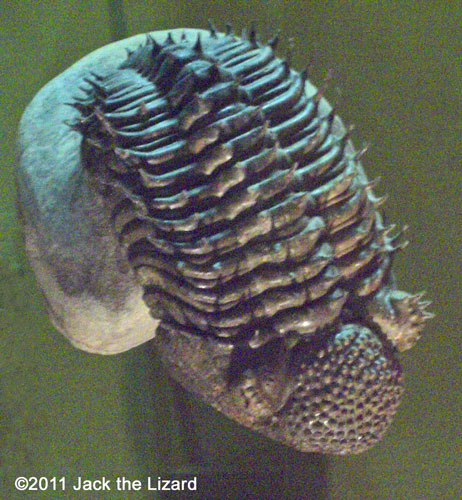 Drotops armatus, Devonian Morocco |
Lilies in the Ocean? Crinoids they were.
 Platycrinus symmetricus Carboniferous, Indiana 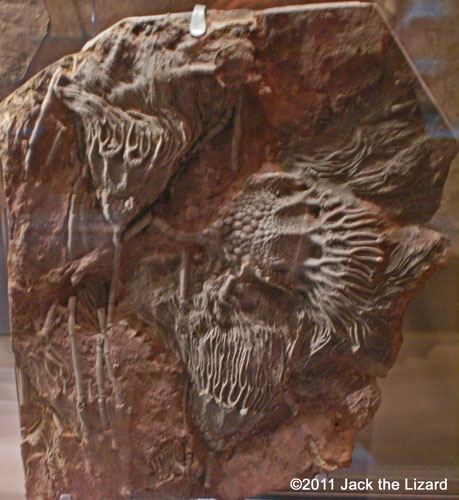 Scyphocrinites sp. Late Silurian, Erfoud, Morocco |
Crinoids diversified their body forms significantly during the Ordovician. Despite of a resemblance of lilies, they were not flowers, not even plants but were marine animals. Crinoids are one of echinoderms which have tube feet, extending water vascular system and stereom, porous skeletal structure. The sea stars and sea urchins now are related to them. The parts on top of its’ stem looked like blossoms were indeed the arms which stretched to filter foods, organic particles from the water. Each crinoid had different length of stems to avoid competition over food. The stems grabbed the ocean floor, looked like plant roots. The crinoids shared the space, allowing great number of them to flourish side by side. |
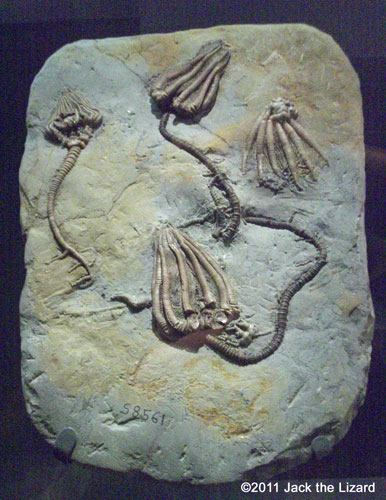 Agaricocrinus splendens Carboniferous, Indiana |
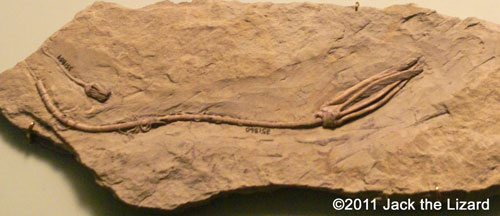 Macrocrinus mundulus, Schytalocrinus hamiltonensis, Carboniferous, Indiana |
||
The Great Permian Mass Extinction
|
The Permian Mass Extinction occurred 252 million years ago. This was the greatest mass extinction ever recorded in the Earth history. 95 percent of life in the oceans and 70 percent of life on the lands were suddenly disappeared. Trilobites, blastoids, placoderms such as duncleosteus were totally extinct during this event while ammonoids, sharks, bony fish, crinoids dramatically lost its’ diversity and population. |
|
Why did many of the animals and plants disappear 252 million years ago?Nobody knows what caused the mass extinction, but scientists explain the huge extinction resulted from some phenomena. First, a huge asteroid or comet might hit the earth. The enormous impact changed the natural atmosphere and ocean chemistry. Second, the Ocean temperature might rise and lose its circulation, which ended up with the lack of oxygen for animal in the Ocean. Massive volcano eruption could be the case too. The greenhouse effect was triggered by tremendous ash from volcano and the global temperature rose. There were some scientists who found the trace of a giant volcanic eruption which expelled half a million cubic kilometres of lava and tossed massive quantities of sulfur dioxide into the air 260 million years ago. It took 20 – 30 million years for ocean to recover the animal and plant diversity, then Triassic period opened as the first era of Mesozoic and dinosaurs came into being. |
Click on the image below for more story about dawn of Triassic dinosaurus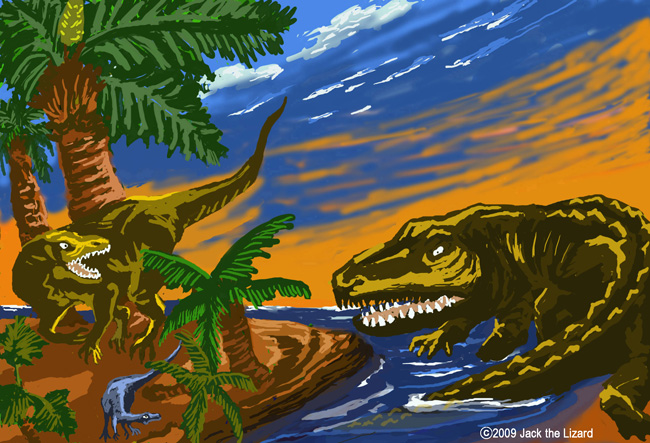 |
